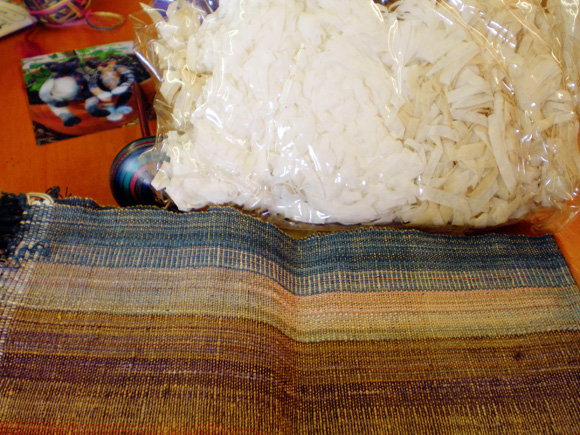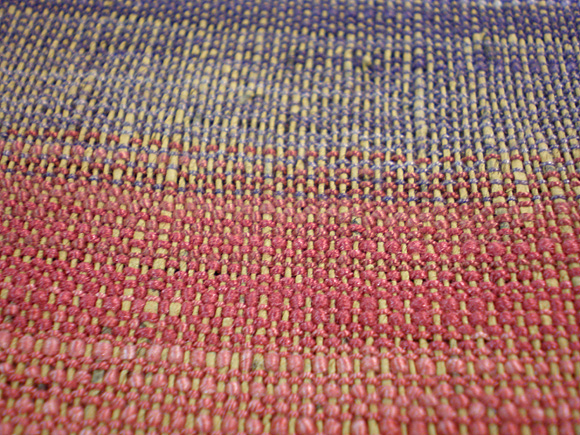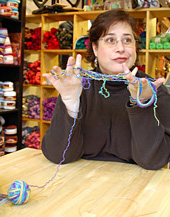
|
This column is about my journey in learning to spin without wool or any other 4-legged animal fiber, using the same tools as everyone else. Spinning in the desert; or, Cotton, I'm coming for you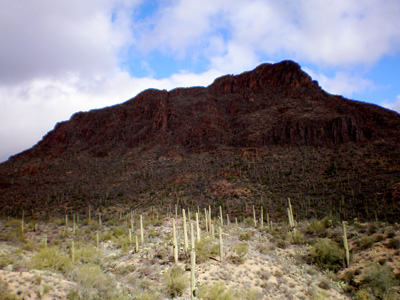 I get to travel quite a bit -- to teach, to speak, and, happily, to meet spinners and knitters wherever I go. It's rather cool. Okay, perhaps cool isn't the right word for this trip. I've just come back from the Sonoran Desert -- Tucson Arizona, to be specific. When I started making plans for this trip, the first thing I thought about was heat. Hotness. Desert = hot. I'm a northern girl who likes winter. I'm not so good in the hot. So the trip was arranged in February, the time of year northerners do best in. I had no idea what to pack, despite checking weather reports. Spring temperatures during the day [15c/ 59f], freezing at night. Later in the week, summer temperatures during the day [28c / 82f], still going down to freezing at night. This wasn't what I thought of when I imagined desert. Clearly Arizonans need to layer to survive the weather...ah! No wonder there are so many fiber people there! 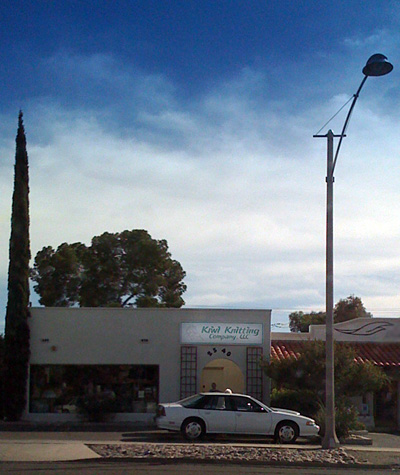 My host for the trip was my friend, Heather [she's the silken voice behind the Craftlit podcast], a spinner first, knitter later, and weaver? I think so. She's definitely multi-craftual. Heather belongs to the Tucson Handweavers and Spinners Guild, and during my week's visit, I heard a lot about the guild, its members and its ongoing projects. By the time Saturday rolled around, I was super excited about attending their monthly Spinning Study Group, held at a local knitting store. Behind the understated facade of Kiwi Knitting Company, I found a shop brimming with yarn of every description. My favorite? The plant room which is the Amy-Friendliest knitting shop room I've ever walked into. The chunky indigo-dyed cotton called my name, but I had to push on, because at the back of the shop, the spinners were setting up for the afternoon. I wasn't sure what to expect [this seems to have been the theme of this trip], but when it comes to hanging around with people who love fiber and spinning tools, I know that comfortable chat is practically assured. This group of fiber people was no exception. 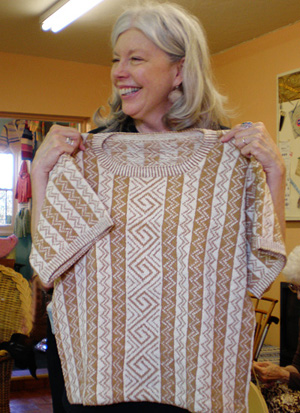 Meet Jill Holbrook. Jill was the facilitator that made this trip happen, arranging schedules and classes and lectures and everything else so that the week was full but not crazy. [I love Jill. The smile you see is what she is -- welcoming and friendly, right away.] The first thing I learned about Jill is that she spins cotton. Oh. Cotton. There hasn't been much mention of cotton in this column, has there? Well, that's going to have to change. I also learned that Jill's mentor is Joan Ruane. Joan is an expert on the subject of cotton, from growing to dyeing to spinning. I have a copy of her learn-to-spin cotton dvd titled Cotton Spinning Made Easy. I will frankly admit here that I have been scared to try spinning cotton. I'm just getting the hang of the longer-staple fibers I can spin, and cotton is so...short. I've had reasonably solid success after success, since Maggie Casey taught me to spin. [This is not to say that I'm a fabulous spinner; I'm still very new. But I am able to spin silk and bamboo and soy and a whole bunch of other stuff without making a mess and having to stop every 5 seconds, and this is what I have feared awaits me when I take cotton in hand.] But after spending a week with Jill, watching her spin cotton on spindles, on her wheel, on tiny tahklis while waiting for the hors d'oeuvres to arrive at our table, fearlessly and with absolute skill, my gumption is collecting itself. I'm finally going to sit down and let Joan teach me how to do it. Cotton Spinning Made Easy, eh? Okay, Joan -- I'm going to give it my best shot. Watch future Knittyspin columns for the results. 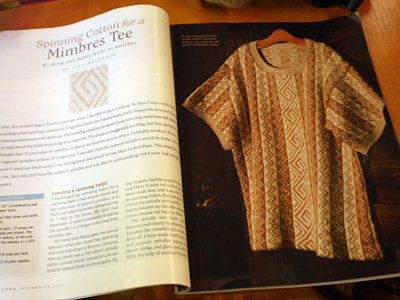 The sweater Jill is holding [above] is made from her own handspun [two different natural colors of organic cotton], and is even more beautiful in person. It's so gorgeous that it was featured in Spin-Off magazine [right]. Jill wasn't the only exceptional fiber person I encountered on my trip to the Sonoran Desert. Meet Esther Hughes [she's shown in the last picture on this page]. Esther introduced herself to me and immedately asked, "Want to see how to spin paper?" I imagined strips of newspaper dangling from a spindle, but Esther soon had my jaw dangling close to the table when she brought out her paper. Esther spins other papery substances. Sewing pattern paper and, most alluringly, coffee filters.  What? Yeah. Coffee filters. The stuff at left isn't from Habu, though it sure looks like it could be. It's strips of coffee filters, spun into yarn. Turns out that coffee filters are made from abaca fiber. Abaca. I had to look that one up, since it's not something we're finding in knitting yarn just yet and it was new to me. Here's what I learned: Abaca grows in the Philippines and the plant looks kind of like a banana tree, except the leaves are skinnier. The fiber is anywhere from 3-9 feet long. Where have you seen it? It's one of the fibers they make paper money out of. You know -- the stuff that's strong enough to survive many accidental machine washings in someone's pants pocket? It's also used to make rope and twine, not surprisingly. Okay, so Abaca is worth spending a little time looking at as a spinning fiber.
Esther brought her raw materials -- a bag of neatly sliced coffee filters. Some have been used, some are right from the package. The used filters were thoroughly rinsed to remove all trace of coffee grounds. That beautiful weaving shown above? That's what Esther made from the coffee filter yarn. The colored sections are made of waste silk thrums and the neutral fibers are the coffee filter yarn. Here, take a closer look.
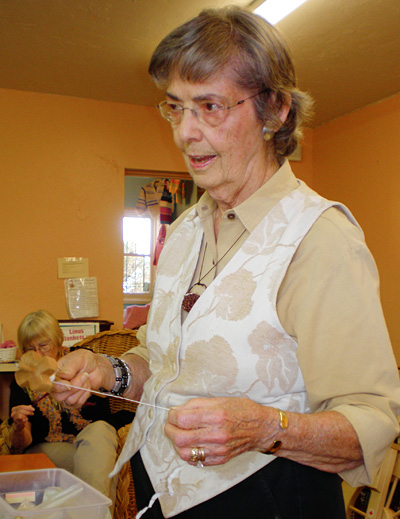 You need 1/4" strips of filter paper for optimal spinning, Esther says -- you can cut them like when you cut the peel off an apple keeping the piece as long as possible. To spin the paper, you need to moisten it a little. A sponge bowl like you use for moistening stamps works well -- don't get the paper too wet. As you can see, Esther [shown at right] spins hers on a handmade top-whorl spindle and was happy to impart the secrets of spinning this mystical fiber to the rest of us. Heather couldn't wait and had it on the spindle right away. Interested to try this, but not fond of natural-colored yarn? Here's what Esther told us to do: take out your box of permanent markers and color the filters before you cut them up. Esther, you're brilliant. The rest of the afternoon was occupied with the sharing of spinning secrets and shortcuts, fiber oogling, wheel admiration and all the good things that are talked about at any gathering of fiber people. Although I kept hearing a loud buzzing noise when people started talking about heddles and reeds [I'm very much not a weaver], I felt quite at home.  Besides a newfound appreciation for the unused coffee filters in the back of my kitchen cabinet, and a fire under my spinning stool to get at the cotton already, I brought something else home with me: a need to find a spinning guild near home. I have so many knitting friends, and opportunity to socialize over knitting at almost any moment. But when it comes to spinning, I'm still pretty isolated. So it's time for me to check out the local guild. It may not be the right fit for me, but I know how much my knitting universe has expanded, for the better, by taking it out of the house. So I'll give it a shot. Thanks, Tucson Handweavers and Spinners! And thank you, Heather [that's her over there on the left], for sharing your guild with me. You are a fortunate spinner to be surrounded by this much inspiration in the midst of the already fascinating cacti, hummingirds and javelinas.
|
| ABOUT THE AUTHOR |
|
She also knows she is tempting fate by writing the previous sentence and will deal with the fallout. |
| Text & images © 2009 Amy R Singer |

